|
|
|
Sort Order |
|
|
|
Items / Page
|
|
|
|
|
|
|
| Srl | Item |
| 1 |
ID:
116448
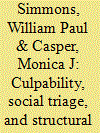

|
|
|
|
|
| Publication |
2012.
|
| Summary/Abstract |
Hurricane Katrina and its effects are often talked about in terms of what has been made visible, as if the hurricane swept through and stripped away our structural blinders along with the levees, revealing social disparities within. Here, we focus instead on whom and what Katrina and its aftermath have rendered invisible. We are concerned with how the seen and the not seen have influenced the ways the purported tabula rasa of New Orleans has been (re)constructed and marked since 2005. We engage with recent debates in political science about power, agency, structure, and culpability, arguing that efforts to prioritize the pursuit of culpability over critique in power analyses, such as the approach advocated by Steven Lukes, risk perpetuating structural violence. We employ the concepts of an ocular ethic and social triage to understand why the storm of the century that was supposed to reveal all has in the end left much concealed, with shocking levels of human devastation unaddressed. Only through careful excavation of the ruins can we begin to comprehend the sedimented inequality and layers of vulnerability that structure violence.
|
|
|
|
|
|
|
|
|
|
|
|
|
|
|
|
| 2 |
ID:
116449
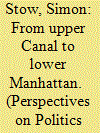

|
|
|
|
|
| Publication |
2012.
|
| Summary/Abstract |
The New Orleans Katrina Memorial is located at the upper end of Canal Street, an inexpensive and relatively short trolley car ride from the city's tourist hub in the French Quarter. Despite its ease of access, and close proximity to the more famous cemeteries to which tourists regularly make pilgrimage, the memorial is little visited and largely unknown, even to many of the city's own residents. In this it stands in stark contrast to the National September 11 Memorial in Lower Manhattan, which drew its millionth visitor less than four months after its opening on September 12, 2011. Recent work in political theory on memory, mourning, and memorialization-as well as Ancient Greek concerns about the same-point to the ways in which the manner of remembrance, grieving, and commemoration employed by a democratic polity help to shape political outcomes. In what follows, I trace the history and design of the New York City and New Orleans memorials to suggest the ways in which they embody and perpetuate national strategies of remembrance and forgetting, in which injustices perpetrated against the polity are prioritized over injustices perpetrated within it. Drawing on John Bodnar's distinction between national and vernacular commemoration, I nevertheless conclude with a counter-intuitive suggestion: that while on a national level the public's relative ignorance of the Katrina Memorial is indeed indicative of a polity more concerned with injustices perpetrated against it than within it; on a local level the erection and subsequent forgetting of the Katrina Memorial is a manifestation of a mode of vernacular memory, mourning and commemoration with far more democratically-productive potential than its counterpart in New York City. In particular, I argue that it cultivates, and historically has cultivated, a more forward-looking, progressive, and polyphonic response to loss than the type of dominant national narratives embodied by the 9/11 Memorial. Whereas the latter continually replays the loss in ways that rob the polity of its capacity to move beyond its initial response, the former acknowledges and incorporates the loss while steeling the community for the challenges ahead.
|
|
|
|
|
|
|
|
|
|
|
|
|
|
|
|
| 3 |
ID:
126418
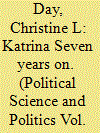

|
|
|
|
|
| Publication |
2013.
|
| Summary/Abstract |
After Hurricane Katrina struck the Gulf Coast in 2005, flooding the city of New Orleans for several weeks after levees collapsed, the city struggled to recover and rebuild. Scholars and activists participating in the roundtable, "Katrina Seven Years On: The Politics of Race and Recovery," at the 2012 APSA Annual Meeting in New Orleans, were to discuss recovery and racial justice in post-Katrina urban planning and rebuilding efforts, grassroots movements, job recovery, fair housing, and cultural revival. Although the 2012 meeting was canceled as Hurricane Isaac threatened New Orleans anew, panelists offered their observations and ideas to be summarized for PS readers.
|
|
|
|
|
|
|
|
|
|
|
|
|
|
|
|
| 4 |
ID:
122546
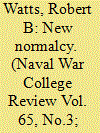

|
|
|
|
|
| Publication |
2012.
|
| Summary/Abstract |
In September 1994, the Caribbean nation of Haiti burst into political unrest that
drove twenty-six thousand migrants out to sea on board overcrowded and unseaworthy craft in an unprecedented mass migration to the United States. Several
months later, over thirty thousand Cubans followed suit, attempting to reach the
mainland on literally anything that could float. On 31 August 2005, a "weapon of
mass destruction" in the form of a category-five hurricane exploded in the Gulf
coast city of New Orleans, killing over 1,300 citizens and forcing the evacuation
of tens of thousands. Finally, on 20 April 2010, the Deepwater Horizon exploratory oil rig exploded, heralding an unprecedented environmental disaster whose
final impact has yet to be determined.
|
|
|
|
|
|
|
|
|
|
|
|
|
|
|
|
| 5 |
ID:
153230
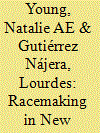

|
|
|
|
|
| Summary/Abstract |
We explore how an ideologically diverse group of white students at Tulane University respond to evidence of racial inequality in post-Katrina New Orleans. In line with prior research, we find commonalities in racialized attitudes and behaviours between students whose racial ideologies otherwise differ. Drawing from anthropological theories of boundary construction and sociological work on colour-blind racism, we argue that the Otherization of non-whites is part of the everyday worldviews and social practices of white Americans. We draw on fieldwork in New Orleans to demonstrate that racist stereotypes and beliefs in racial difference continue to be transmitted within white social spaces. We find that even the most progressive Tulane students are engaged in the construction and reinforcement of symbolic and spatial boundaries between themselves and African Americans. This achieves the purpose for which racial stereotypes were originally constructed – namely, the persistence of racial inequality.
|
|
|
|
|
|
|
|
|
|
|
|
|
|
|
|
| 6 |
ID:
117168


|
|
|
| 7 |
ID:
101282


|
|
|
|
|
| Publication |
2010.
|
| Summary/Abstract |
This article analyzes the changing ways law enforcement agencies, city government officials, and gentrifying resident constituencies have attempted to criminalize and surveil disposition-forming rituals and daily social practices of African American working class New Orleanians before and after Hurricane Katrina. The rituals and practices discussed include pedestrian parades known as Second Lines and Super Sunday. The article demonstrates that the criminalization and surveillance of these practices must be understood in light of the role played by socially structured space in the production of racialized class differences among New Orleanians. In the post-Katrina context, the city's mandatory evacuation enabled gentrifying resident constituencies and expert urban planners to imagine the city's reconstruction as something to be achieved through the creation of architectonic relationships conducive to cycles of capital investment. These visions of urban recovery have ignored the importance residents of affected neighborhoods place on the reinstatement of the city's pre-Katrina population, which is responsible for the production of Second Lines and Super Sunday. This article explores how the policing, surveillance, and criminalization of Second Lines and Super Sunday have historically operated as mechanisms for upholding hegemonic orders, and the intimate connections between planning, race, and gentrification in the US.
|
|
|
|
|
|
|
|
|
|
|
|
|
|
|
|
|
|
|
|
|